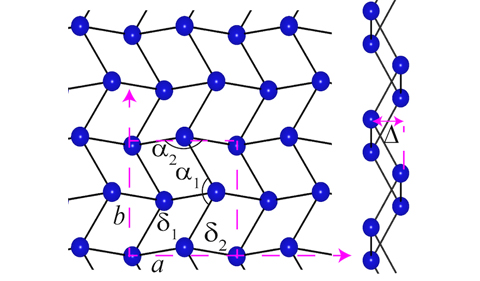Dr. Anthony Stender, Assistant Professor of Chemistry & Biochemistry at Ohio University, is a co-author with scientists at Rice University and the Indian Institute of Science, Bangalore, on the discovery of a method to make atomically flat gallium that shows promise for nanoscale electronics.
“The Rice lab of materials scientist Pulickel Ajayan and colleagues in India created two-dimensional gallenene, a thin film of conductive material that is to gallium what graphene is to carbon,” according to a news release headlined “Flat gallium joins roster of new 2-D materials: Rice University, Indian Institute of Science introduce gallenene.”

A model of the structure of gallenene is shown after exfoliation from bulk gallium. Scientists at Rice University and the Indian Institute of Science, Bangalore, discovered a method to make atomically flat gallium that shows promise for nanoscale electronics. Courtesy of the Ajayan Research Group
Extracted into a two-dimensional form, the novel material appears to have an affinity for binding with semiconductors like silicon and could make an efficient metal contact in two-dimensional electronic devices, the researchers said….
Gallium is a metal with a low melting point; unlike graphene and many other 2-D structures, it cannot yet be grown with vapor phase deposition methods. Moreover, gallium also has a tendency to oxidize quickly. And while early samples of graphene were removed from graphite with adhesive tape, the bonds between gallium layers are too strong for such a simple approach….
Co-authors of the paper are graduate student Yuan Zhang and Associate Research Professor Robert Vajtai of Rice; Anthony Stender, a former Rice postdoctoral researcher and now an assistant professor at Ohio University; Sanjit Bhowmick, Praveena Manimunda and Syed Asif of Bruker Nano Surfaces, Minneapolis; and Rice alumnus Abhishek Singh of the Indian Institute of Science. Ajayan is chair of Rice’s Department of Materials Science and NanoEngineering, the Benjamin M. and Mary Greenwood Anderson Professor in Engineering and a professor of chemistry.
The article, “Atomically thin gallium layers from solid-melt exfoliation,” was published in Science Advances.
Abstract: Among the large number of promising two-dimensional (2D) atomic layer crystals, true metallic layers are rare. Using combined theoretical and experimental approaches, we report on the stability and successful exfoliation of atomically thin “gallenene” sheets on a silicon substrate, which has two distinct atomic arrangements along crystallographic twin directions of the parent α-gallium. With a weak interface between solid and molten phases of gallium, a solid-melt interface exfoliation technique is developed to extract these layers. Phonon dispersion calculations show that gallenene can be stabilized with bulk gallium lattice parameters. The electronic band structure of gallenene shows a combination of partially filled Dirac cone and the nonlinear dispersive band near the Fermi level, suggesting that gallenene should behave as a metallic layer. Furthermore, it is observed that the strong interaction of gallenene with other 2D semiconductors induces semiconducting to metallic phase transitions in the latter, paving the way for using gallenene as promising metallic contacts in 2D devices.

















Comments